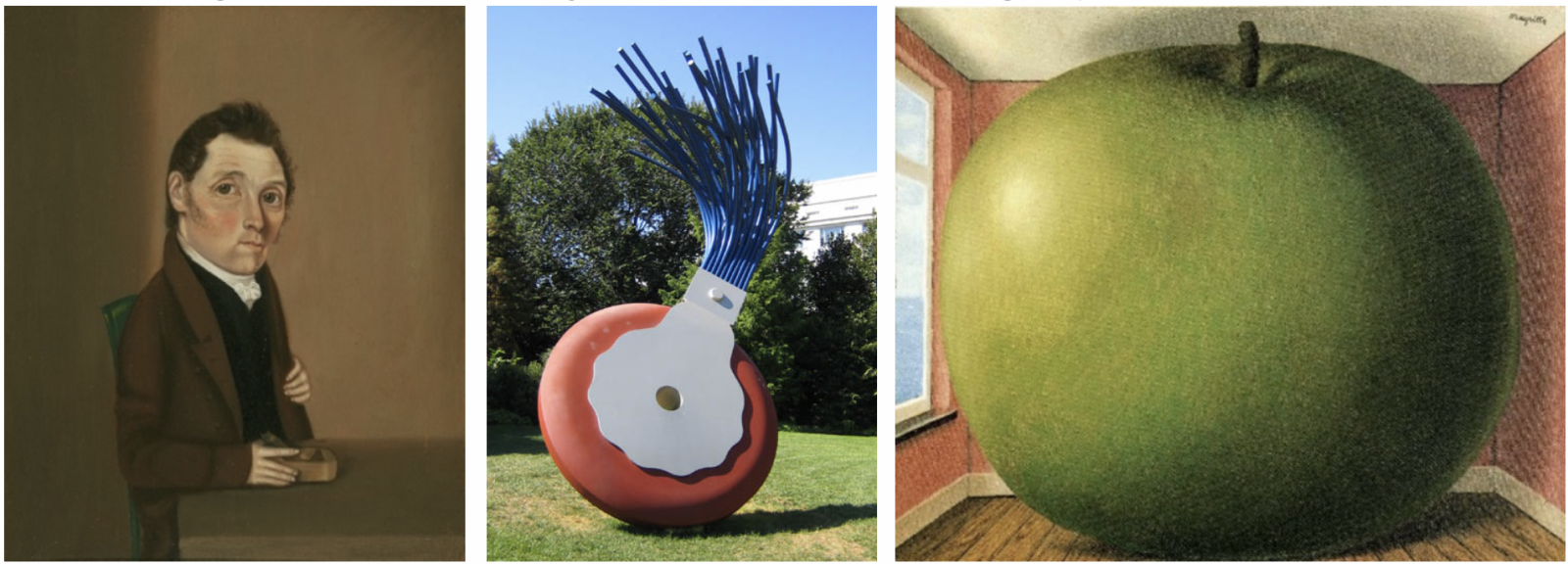After observing the work of Magritte and other artists, students will paint an apple on an acrylic sheet in Magritte's style to better understand the principle of scale. Recommended for 2nd Graders.
Line: a long narrow mark or stroke made on or in a surface.
Contrast: using opposing elements next to each other to create visual interest, excitement and drama.
Proportion: the relationship of parts of a single object to the whole.
Scale: the relationship between a created object to the original real object.
Contour-line drawing: a line drawing that follows the visible edges of a shape or form, both exterior and interior.
Surrealism: beyond reality, dream-like.
Magritte was a surrealist painter from Belgium. Surrealism means beyond reality. Surrealist artists would often paint dream-like images. He painted life-like spaces and objects in ways that made you wonder about them. In this painting, The Listening Room, he painted an apple that fills the room. The contrast in scale between an actual apple and the one that appears to fill a room creates drama.
Look at some artwork with things that have different size relationships (scale) to each other. We expect to see things have a certain scale as they appear in real life.
Hold up the typewriter eraser and apple. Show the following images: William Bonnell – Naïve painter; Magritte – The Listening Room; Claes Oldenburg – Typewriter Eraser.

What happens when artists change the scale on us? How does that make us feel? Do you think that the apple is big or the room is small?
Are these things ‘real’? Which part isn’t real? It’s the relationship between them that makes us question if they are real. When does the scale of the created object contrast highly with the real object?
Students will:
Set up by preparing the trays with paint and displaying the photos or art work you will be referring to. Write the definitions of elements and principals mentioned above on the whiteboard.
Demonstrate how to flip the acrylic sheet over the image with their name facing down (backwards so they can’t read it).
Lesson written by Juliette Ripley-Dunkelberger. Artworks care of the Art Institute of Chicago’s free library of images.
21st Century Thinking Skills
Visualizing, comparing & contrasting, cecision making, determining point of view, thinking flexibly, sequencing.
Following directions in correct order. Reverse glass printing has a unique sequence. If one does not follow the sequencing pattern, the artwork will not look as desired
Predicting: determining what will happen next.
Cause and Effect: recognizing actions and their reactions. For this lesson to be successful, students must plan and execute in a determined and thoughtful order.
WA State Learning Standards
(VA:Cr1.2.2) a. Make art or design with various materials and tools to explore personal interests, questions, and curiosity.
(VA:Cr2.1.2) a. Experiment with various materials and tools to explore personal interests in a work of art or design.
(VA:Cr2.2.2) a. Demonstrate safe procedures for using and cleaning art tools, equipment, and studio spaces.
(VA:Cr3.1.2) a. Discuss and reflect with peers about choices made in creating artwork. This happens if you are talking about images used in the lesson, or about students’ work.
(VA:Re7.1.2) a. Perceive and describe aesthetic characteristics of one’s natural world and constructed environments. This happens when you compare objects from real life and the distorted scale of objects in Surrealism.
(VA:Re9.1.2) a. Use learned art vocabulary to express preferences about artwork.
(VA:Cn11.1.2) a. Compare and contrast cultural uses of artwork from different times and places. This happens if the docent explains Surrealism as a response to the culture of its day.
Arts Integration Opportunities
Math: the concept of scale can be examined using numbers.
Please note: These lesson plans are intended for non-profit use only. Use of these plans for commercial purposes should give attribution to the Issaquah Schools Foundation and be accompanied by a nominal donation at www.isfdn.org/donate. Thank you.
Fueling Success for Every Student, Every School